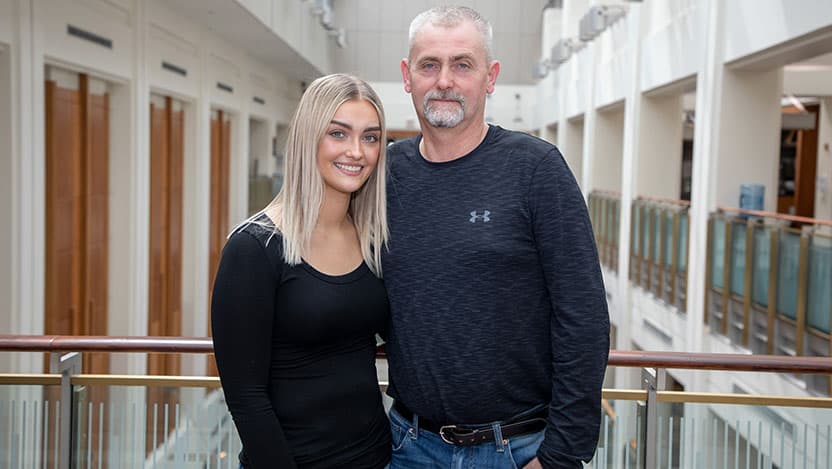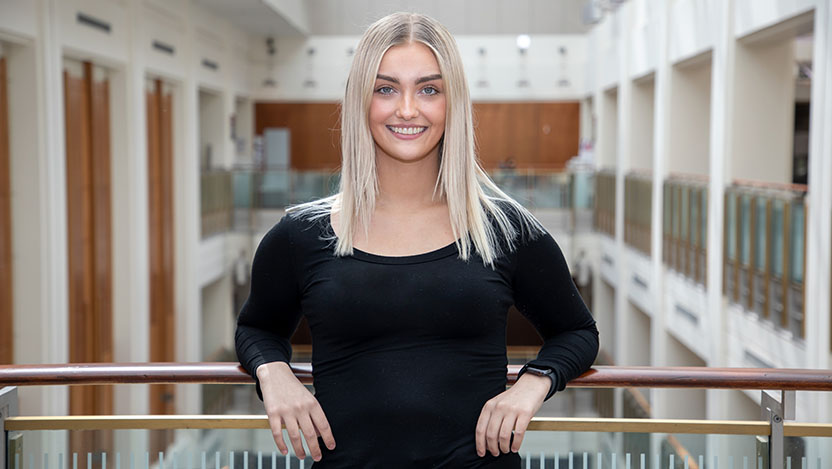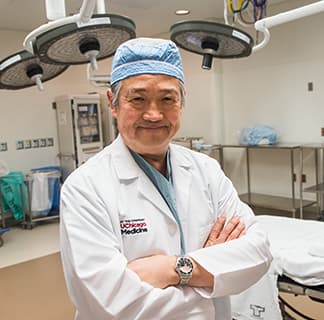Living liver donation: A father’s life-saving gift

Jessica Zubek was 9 when she was diagnosed with autoimmune hepatitis, a condition where the immune system attacks the liver.
By the time she was 16, her liver disease progressed to the point where doctors recommended a transplant. But because Jessica wasn’t critically ill in 2015, she faced a long wait on the transplant list.
Liver disease specialist Helen Te, MD, offered another option: a donation from a living organ donor. Because the liver has an incredible ability to grow back, doctors can take a portion of healthy liver from a donor and transplant it to the recipient. Both donor and recipient livers regenerate and function normally after a few months post-surgery.
It’s the most generous thing a human being can give to another: a piece of themselves to help life go on.
But Jessica encountered health complications, and the wait continued. This year, she successfully received received a living donor transplant, with her father serving as donor.
The University of Chicago Medicine pioneered the field of liver transplant. In 1989, it was where the first living donor liver transplant in the world was performed. UChicago Medicine ended 2022 as Illinois’ largest living donor transplantation program, performing more than half of the living liver donor transplants in Illinois last year, with a 100% one-year survival rate for living donor liver transplant recipients.
Dad offers to be her living donor
“Living donor transplant is such a critical resource, especially for patients who could wait months and years without getting a transplant,” said transplant surgeon Rolf Barth, MD, who headed Jessica’s surgical team.
The list of those waiting for liver transplants in the United States is much longer than the number of livers available, and each year, hundreds of people are removed from the list because they become too ill for a transplant or die before an organ becomes available.
Learn more about our living donor liver program
Back in 2015, Jessica’s father Stanislaw volunteered to be a living donor and appeared to be a great match. He and his daughter had the same blood type. He was about 40 (living donor candidates must be between 18 and 55) and he passed extensive health tests. But the surgery didn't happen as planned.
Jessica’s condition was complicated by bleeding in her upper gastrointestinal tract due to cirrhosis (severe scarring) of the liver. She underwent a bypass procedure called transjugular intrahepatic portosystemic shunt (TIPS) to lower blood pressure in her liver and control the bleeding.
The bypass was successful, Jessica's condition stabilized, and she was taken off the transplant list. She became a cheerleader, a talented artist, and played soccer for two years in high school. But her disease continued to progress.
Time for a transplant, again
Fast-forward to August 2022: Jessica returned to the hospital with another bleed. Though doctors repaired the TIPS, “We decided it was time to pursue liver transplant again to avoid a recurrence of the bleed in the future,” Te said.
Jessica’s father stepped up a second time. Father and daughter underwent surgery in January 2023. They left the hospital together within a week.
Jessica, now 24, felt like a new person within just six weeks of the transplant.
“Me and my dad both feel amazing. I was always tired; I always needed a nap. Now I don’t need that — I feel like I was reborn,” she said.

Recovery together and back to normal life
The two have been grocery shopping and taking walks around their neighborhood in Chicago's south suburbs, and Jessica’s eagerly awaiting her doctor’s OK to return to work as a dental assistant. Construction worker Stanislaw, 49, needs a few more months to rest before resuming his physically demanding job.
January 24 was the best day of my life. It’s amazing what the human body can do and the fact that my dad donated this makes it extra special.
“After the surgery when I went to visit Stanislaw, he was so grateful,” said Rose Dwyer, APN, interim living liver donor coordinator and a part of Stanislaw’s surgical team. "He said it had been 15 years coming and he was so happy it was finally done. This is such a kind and loving family and they’re so supportive of each other.”
“What dad wouldn’t do this?” Barth said. “He was so happy to give his daughter the gift of a new life.”
Once you’re a transplant patient, explained Barth, you’re linked to a multidisciplinary team, including surgeons, nurses, the transplant hepatologist, social workers, nutritionists, all specializing in liver transplant.
Read our tips for finding an organ donor
“We both met the team and we both felt so safe,” Jessica said. “Everyone made us feel so comfortable and so positive.” After she woke up in the operating room, Jessica looked around and saw nurses and doctors giving her a thumbs up. “I asked, ‘Did I do it?’ And they told me, ‘You did it, you have a great, beautiful liver.’”

World-Renowned Transplant Specialists
The University of Chicago Medicine is home to hundreds of medical experts.
Find a transplant specialist